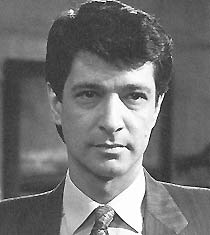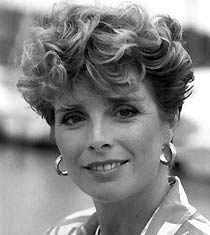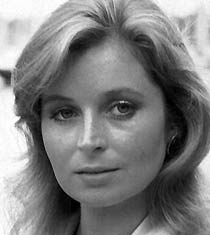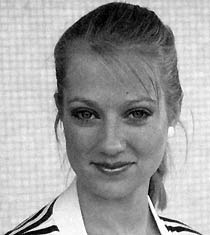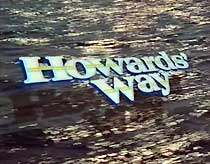
|
SERIES INTRODUCTION by Matthew Lee © 2005-2008 WARNING - THIS GUIDE CONTAINS SPOILERS The essential concept for Howards’ Way emerged from a meeting with BBC Television Head of Drama Serials, Jonathan Powell, and prolific programme producer Gerard Glaister, during which the discussion turned to possible ventures for insertion in the forthcoming Autumn 1985 schedules. So impressed had Powell been with Glaister’s 1970s serial The Brothers (a series which concerned itself with a Midlands haulage firm and the boardroom and bedroom battles waged in and around its premises) that he approached the man in question with a proposition for the development of a Sunday-evening serial which would, he hoped, attract average viewing figures of approximately eleven million. When Glaister had pooled his collaborative talents with N J Crisp to devise the framework for The Brothers, various settings and scenarios had been considered, one of which had been that of boat-builders. Given the budgetary limitations of the time, the idea was swiftly abandoned, yet Glaister always retained the principle concept with the hope of eventually realising it. Powell’s offer presented him with the ideal opportunity, though on this occasion he would collaborate with Allan Prior rather than continue his long-time partnership with Crisp. Bearing the working title of The Boatbuilders, Glaister and Prior developed a treatment for the series: “Two things were needed to give a new drama serial fresh angles and originality. The first was to interweave the work background more than it had been in other serials, apart from those set in workplaces which directly reflected the drama, such as hospitals and police stations. In The Brothers, the road-haulage business was merely a background, just as the oil business is in Dallas; but boatbuilding was much more visually attractive and interesting than lorries or oil. Plenty of people would relate to it, because nearly everybody likes boats, and thousands own them – from simple dinghies to luxury cruisers – and boat ownership is on the increase. As the idea for the serial took root, a mix was agreed of one-third boats, one-third business, and one-third personal relationships. The second element was to replace the familiar locations of kitchen, back garden, corner-shop and public bar. The world of boats would get the actors and the action out of doors, and into a world no less real than that of the terraced provincial street or Cockney pub, but which hadn’t been seen so much; the world of the wealthy, who live well, who are successful and who can afford a more glamorous life than most of us. Without failure and the danger of failure there is no drama; but adversity doesn’t always mean a shortage of money” (Howards’ Way – The Story Of The BBC Television Series by Gerard Glaister and Ray Evans). The pair elected to set the series in Hampshire (or more accurately the districts in and around Southampton), establishing the fictitious locality of Tarrant, which would be based along the River Hamble. The series would divide itself between the fictional Mermaid Yard, a boat-building concern currently enduring harsh times, Relton Marine, a prosperous and thriving concern with room for expansion, and Frere Holdings, a conglomerate renowned for decisive raids on vulnerable businesses at high yield. However, whilst this triad of businesses would form the framework of the production, the essential core of the series would find its foundations in the Howard family, the patriarch of which had unexpectedly been made redundant. Thematically speaking, such a premise was relatively ahead of its time, as the trend towards making middle-management redundant would become a more prominent statistic during the late 1980s and early 1990s. With the programme title now changed to Howards’ Way, casting was executed and locations sought in preparation for a summer shooting schedule in advance of the provisionally slated September 1st transmission date. A writing team of Jill Hyem, Patrick Carroll, Michael Robson, Raymond Thompson and Arthur Schmidt were employed to translate Glaister and Prior’s storylines from treatments to scripts, and directors Pennant Roberts, Sarah Hellings and Tristan de Vere Cole were afforded the responsibility of their visual realisation. Glaister had a very specific visual “house style” in mind for the series itself: “In what was by now Howards’ Way, since the name of the principal family had been decided, a definite unity of style is easy to see – but it goes further than dovetailing characters with the clothes they wear, the cars they drive, the places they live, and the music which supports them. The style extends to the way the programme is shot. There are no long panning shots, and no pandering to scenic backgrounds – when they are there they are integrated. Shots are kept tight, angles interesting. The action moves forward all the time, and the characters are never static (as they are in Dallas, for example, where experience never changes them) but develop, whatever the consequences; which means that, unlike many open-ended sagas, they do not fall into the trap of endless repetition” (Howards’ Way – The Story Of The BBC Television Series by Gerard Glaister and Ray Evans). The importance of pace was perhaps the most notable feature of the series, the attention to which was influenced by the arrival of EastEnders in BBC Television’s schedules some seven months earlier. That particular series prided itself on the ability to produce short, sharp sequences which spanned no more than one-to-two minutes and ensured that audiences were constantly kept entertained with the “spliced” format of breaking up an extended scene into shorter bursts. Howards’ Way would employ a similar style, with short, tightly-paced scenes interspersed with more languid, aerial sequences of various sailing vessels and the like. The ability to steadily pace the material covered in each episode enabled a wide variety of interlocking storylines to be played out over the course of thirteen-part seasons, with the soap-stylised cliffhanger endings to each episode providing a suitable re-entry point at the start of each subsequent part. Music for the series was, as with all Glaister productions, distinctive and of a higher calibre than the majority of fare which was transmitted alongside it. Simon May, who had provided the score to Glaister’s thriller serial Cold Warrior in 1984, and who had also provided the award-winning signature tune for EastEnders, was employed in collaboration with Leslie Osborne to provide the signature tune and incidental music for Howards’ Way. For the opening titles, the pair established a flighty arrangement which employed synthesizers and violins to be set against the backdrop of a yacht sailing in brilliant sunshine, which culminated in the camera appearing to dive beneath the surface of the water as the vision mixed into the episode itself. For the first series, the closing titles were a simple rearrangement of the signature tune, this time set against the backdrop of a silhouetted bust of a Mermaid (which would, in the passing of time, become much derided as a somewhat masculine woman as opposed to the figurehead reflecting the Yard in the series): “Music is a crucial element in Howards’ Way, and Gerry (Glaister) was careful in his choice of composer. Simon May had worked with him before, and using him again has more than paid off. The Howards’ Way theme has been in the Top Twenty twice – in its original series one version and again in the wistful series two arrangement, with lyrics sung by Marti Webb. `My brief from day one was to write music that would not only provide a theme for the serial but also accompany certain characters,’ says Simon. He had talks with Gerry to get a feeling for the programme and gathered as much material as he could about it and its background. `I find it very important to get as deeply involved as possible to ensure that the music doesn’t sound stuck on’. The main theme reflects the sea and links itself to the Howard family. It suggests an element of triumph in Tom’s managing to overcome the misfortune of his redundancy. The acoustic guitar introduction then broadens the base to include the whole family. Following solid Wagnerian precepts, Simon has gone on to create themes for Frere, Abby and even the Barracuda. `I wrote a sleazy saxophone motif for Ken and Dawn, too, and even though Dawn’s long gone the sax stuck with Ken for a while’. However, as the characters develop and change, so does their music: `The thing is to hug the characters’” (Howards’ Way – The Story Of The BBC Television Series by Gerard Glaister and Ray Evans). Thus, as the programme progressed, signature tunes for characters such as Charles Frere, Ken Masters, Jan Howard, Jack Rolfe and Abby Urquhart became prominent features in the incidental music accompanying the episodes. Stock music was essentially only employed for the purposes of the various fashion and boat in the series, with May and Osborne provided a fresh score for virtually every episode. The first season of Howards’ Way, budgeted at approximately two-million-pounds (with sixty-five-thousand dedicated to production costs), employed one of the largest casts for a non-period BBC Television production, with some fourteen primary cast members and a vast array in support. Employing the services of a wide collection of sea-faring vessels (mostly notably the yacht branded Flying Fish) and mounting a rare enterprise in which seventy-five percent of each episode was recorded on location as opposed to studio settings, Glaister had ensured that Powell’s request for a high-calibre, ratings-drawing production had been entirely met. Transmitted in Autumn 1985, the programme secured over twelve-million viewers per episode, and a second season was commissioned after its first four weeks on air. However, several changes would be employed for its long-awaited return (which would fall one day short of an entire twelve months since its premiere) to further buoy and consolidate audience figures and further heighten the programme’s dramatic capabilities. Despite popular misconceptions, the production team employed on Howards’ Way always recognised and acknowledged the soap-serial potential of the series. Much of the media assessment of the series had branded it as nothing more than a collection of cheap hokum, with actors delivering cringeworthy lines against the backdrop of multiple bed-hopping. However, part of the guilty pleasure of enjoying Howards’ Way is that it consolidated, harnessed and capitalised upon all the best clichés, nuances and styles which soap-serials (as particularly exemplified by EastEnders) offered audiences, and sustained an addictive quality which saw viewers returning in droves on a weekly basis, and enduring the after-effects of such addiction between seasons. BBC Television, a corporation for whom the soap-serial genre was always an uncomfortable concept, nevertheless happily concurred with the production unit’s acknowledgement of the direction Howards’ Way determined to set about pursuing from Day One, and provided audiences which an opportunity to reacquaint themselves with the culmination of the previous season’s cliff-hanging material by repeating the final episode of the first season prior to the premiere of the second, in August 1986. Critical appraisal of the second season of Howards’ Way once again cited the soap trimmings of which the programme’s production team were justly proud, although on this particular occasion much was made of the choice of Marti Webb to perform Don Black’s lyrics over the closing titles of the season, which now featured a languid aerial pursuit of a yacht (apparently The Flying Fish) carving its way across a brilliantly blue sea. The tune, entitled Always There, whilst commanding a respectable presence in the popular music charts, failed to set the world ablaze, as it were, but did appear to be a logical inclusion for the series (given the nature of the content featured in the second batch of thirteen episodes): “In series two, the original theme was rearranged as a wistful ballad, sung by Marti Webb, to reflect the romance and sadness of the main stories” (Howards’ Way – The Story Of The BBC Television Series by Gerard Glaister and Ray Evans). A large proportion of the media proclaimed that the series was nothing more that cheap soap, and that the closing theme was a perfect reflection of BBC Television’s desire to replicate the chintzy soap gloss of more high-profile American serials such as Dallas and Dynasty, yet this is far from the point; an examination of the lyrics of the tune itself underline its necessary inclusion in the second season, not only underlining the romance-sadness point, but also as the theme best described the varying romantic and business fortunes of Tom and Jan Howard, both of whom were forging new careers at the expense of familial and personal relationships. Unlike similar soap-serials which reserved their foundations in the principle family around which the storylines would flow, Howards’ Way swiftly side-stepped the conventions of its counterparts by having explored the Howard family (and the rise and fall of their varying fortunes) in the first season, and spent the second season concerning itself with the business fortunes of the Mermaid Yard (with Tom Howard making a more lasting impression to arrest the firm’s downward spiral with the design of the Barracuda and the Lynette catamaran), Frere Holdings (with Charles Frere’s pursuit of a vast marina project and his hostile intentions towards Relton Marine), and Leisurecruise (the firm jointly created with Ken Masters, Mark Foster and his attractive wife, Sarah, with whom Ken would later cultivate a relationship to serve his own ends). Romantic entanglements centred on Lynette Howard (who would later marry her mother’s prized French designer, Claude Dupont, but his tragic death at the conclusion of the season would pave the way for her departure from the series) and Abby Urquhart (who enjoyed a budding romance with Leo Howard, despite having given birth to the son and heir of Orrin Hudson, an American she met whilst in Switzerland). The surprise of the second season came in the form of the revelation that Frere’s trusted aide, Gerald Urquhart, was in fact a homosexual, and his sham marriage to the social-climbing Polly was revealed to have been nothing more than a convenience on her part to disguise the fact that Abby’s real father was, in fact, Charles Frere, with whom she had been involved whilst at University together. A thoroughly bizarre Animal Rights storyline (which featured a reactionary activist with whom Abby had a torrid and brief affair) and a short-lived affair between Jan and Ken Masters served to spice up the content, whilst a guest appearance from Hugh Grant (as an evangelist) matched the turn provided by Anthony Stewart Head (as a lascivious yachtsman) during the first season. Such was the success of Howards’ Way by this stage that the commissioning of a third season was inevitable. Transmitted in Autumn 1987, it consisted of further casting, production and musical changes, but the content of the season itself was somewhat more assured than in the previous two years, with a more precise focus on three or four primary storylines as opposed to every character pursuing their own divergent plots. Having overcome Richard Shellet’s legal challenge against them, the fortunes of the Mermaid Yard had appeared prosperous until the Lynnette catamaran disaster which played out at the climax of the second season. An inquiry into the precise cause of the accident was the primary storyline emerging from the Yard throughout the third season, with the budding relationship between Tom Howard and Emma Neesome, and Tom’s consideration of “going it alone”, providing support to this storyline. Charles Frere’s father, Sir Edward, was introduced as a business rival to Frere’s marina development plans, and whilst the two grappled on a personal and financial footing, Ken Masters became an unwitting pawn between them. Stylistically, the third series represents the peak of the production, with the pacing of scenes enabling the content to be broached at relatively break-neck speed. The programme was staged on a more assured footing, with the business machinations far outweighing the personal relationships which had been the lifeblood of the first two years. Simon May and Leslie Osborne produced a fresh orchestration of the closing signature tune to be played over the newly-recorded closing titles, which featured an assortment of vessels (Barracuda steered by a Tom Howard-lookalike and crew, and a powerboat seemingly manned by a Ken Masters-lookalike) racing across the waterways. The tune itself, which was entitled Barracuda, was intended to reflect the prosperous times enjoyed by the characters featured in the third series, and in turn reflected the prosperity of the series when it enjoyed a high placing in the music charts. Howards’ Way also reached the peak of its global popularity during this season, with worldwide export sales for the three series (now comprising thirty-nine fifty-minute episodes) spanning sixty countries, with three television tie-in novelisations of the respective seasons and a behind-the-scenes text on the way. Media interest in the series itself was also heightened, partly owing to the slick visual presence of the production, and partly as a result of the behind-the-scenes turmoil which was also taking place. Two marriages had ended acrimoniously, whilst Tony Anholt and Tracey Childs were married, and Stephen Yardley and Jan Harvey found their relationship splashed across the pages of the tabloid press. Notoriety is often the best companion for a television series, however, and such free publicity certainly ensured that a fourth series of the programme was readily commissioned. September 1988 ushered in the fourth and “final” series of Howards’ Way, and although the season was not heralded in any of the popular press or television periodicals as drawing the production to a close, Glaister and a handful of BBC Television executives had elected to conclude the remaining storylines, tie together any loose threads and sail off into the sunset in late November. The third series had climaxed with an aircraft accident in which audiences had been left on the edge of their seats: Charles Frere, having just proposed marriage to partner Avil Rolfe, failed to obtain a response before their aircraft ditched into the sea. Now the search was on the locate the pair, and as the price of Frere Holdings shares collapsed, the oily Ken Masters was on hand to make a tidy profit. Unlike previous outings, this season would employ a great deal of soul-searching on the part of what had now become labelled the “Gin And Tonic” Thatcherite set (indeed, by this time the programme itself had become known in television circles as a self-indulgent avarice soap-serial). Charles Frere, reassessing his life after the accident, engaged in a pursuit of the finer things in life (closer ties with his daughter, his passion for the arts, and salvaging the remains of his relationship with Avril Rolfe), before his dormant business acumen eventually became his overriding concern once again; Jack Rolfe, overcoming his guilt at having married years earlier so as to secure the Mermaid Yard, engaged in a budding relationship with former flame Vanessa; Abby Urquhart once again became embroiled in her determined pursuit to obtain custody of her son, William, from the scheming Orrin Hudson; Jan Howard finally broke all ties with Tom and Ken in a bid to finally “go it alone”; and, perhaps most famously, the revelation of Gerald Urquihart’s homosexuality, which came as much of a surprise to Ivor Danvers as it did to audiences. Employing the scripting services of Raymond Thompson, Anthony Osborn, Douglas Watkinson and Mervyn Haisman, this fourth series culminated in what was considered the logical conclusion to the series: Ken Masters, having often fallen victim to the business machinations of Sir Edward and Charles Frere, and spurned by Relton Marine, secured a fantastic victory in the Guernsey Gold Cup (despite Leo Howard’s tragic powerboat accident), proudly boasted of his prowess over his “betters” (having elaborately implicated Frere and company in allegations of fraud) despite the fact that his success came at the cost of his relationship with Jan Howard. Having tied together the threads of Leo and Abby’s relationship (with the former coming off second best), Jan’s budding fashion concern, Tom Howard’s relationship with Emma Neesome, Gerald and Polly’s sham of a marriage, Jack and Vanessa’s relationship, and Frere’s bold plans for Relton Marine, audiences had effectively witnessed the last chapter in the Howards’ Way saga. Or so they thought … Market forces and healthy export sales saw to it that, despite having closed the book on flourishing storylines, Howards’ Way returned for a fifth series in Autumn 1989. Such were the buoyant profits BBC Television were enjoying with the series that the insertion of far greater overseas location footage (Malta being the requisite “place to be” throughout this season; whilst the previous season had featured scenes seemingly set in Cannes, the actual footage had been recorded in the South of England) and the capacity to mount the production on an international scale (in terms of the personal and professional lives of the characters) elevated the scale of the programme far beyond British shores. With a lavish budget of some half-a-million pounds at their disposal, the production team were able to excel where The Power Game and The Plane Makers (perhaps the nearest ITV commercial equivalent to this series) had never been able to do so. Mounting location shooting blocks amidst vast yacht races, powerboat races, and a considerable quantity of aerial footage and bringing the more prominent characters to Malta (for one reason or another), the fifth season had lost none of the gloss and glamour that previous outings had offered audiences. However, whilst the storylines which emerged where of a back-to-basics nature (picking up the threads of Frere’s fraud trial, Jan’s budding fashion enterprise – having changed from Periplus to HowardBrooke, Relton Marine (with Avril Rolfe at the helm) and Abby and Orrin’s custody battle of baby William, a far more pressing matter arose quite unexpectedly. Maurice Colbourne’s untimely death towards the end of the fifth series of Howards’ Way presented the production team with a logistical nightmare. Scripts were hastily re-written, and production schedules were changed to accommodate Tom Howards’ sudden departure (last seen in Malta, the character became involved in a re-fit contract and was often referred to as having either spoken to another character over the telephone, or later manning a vessel en route from the Bay of Biscay to Tarrant, whereupon he met an untimely end when he drowned during a terrible storm which was eventually set between the fifth and sixth seasons of the programme) from the ongoing storylines. Colbourne’s death hit the production team hard, and left Glaister to consider whether or not it would be considered appropriate to continue Howards’ Way in the absence of the patriarch who had, for so long, been a central component of the programme. Ultimately, however, Howards’ Way did return for a sixth and positively final season, with the opening episode set some sixth months after the dramatic events which had closed the previous series (with Abby involved in a hit-and-run accident in which he went into premature labour and gave birth to a son, Thomas Leo). At the christening of the new-born baby, viewers were given a necessarily brief explanation for Tom’s abrupt departure from the series, and although the production unit hoped this would be an end to the matter, his absence – and the decision to produce a further thirteen episodes after Colbourne’s death – overshadowed the last sojourn of the programme. Ken Masters, having been taken to the cleaners by business partner Laura Wilde (the introduction of Kate O’Mara to the previous season as the requisite “rich bitch” the series had apparently been lacking proved a momentary ratings success, but her appearances rapidly descended into a parody of her tenure in Dynasty), returns to Tarrant with his tail between his legs, having lost control of Leisurecruise and now forced to work from the confines of a ratty port-a-cabin in a desperate bid to regain all which he has so far lost. Jan Howard, bereft at having James Brooke walk out on her, seeks a new direction with The House Of Howard, her newly-named company, but finds difficulty in convincing the bank of her financial viability. The death of Sir Edward Frere (having married Gerald Urquhart’s social-climbing wife, Polly) established a new power broker in the business fray: Abby Urquhart, charged with being a co-executor of his will (along with Orrin Hudson), breaks away from Leo in a bid to secure custody of her child, William, and that of baby Thomas, by aligning herself with Orrin. The wealth and power now at her disposal enables her to fight both the Hudsons and the Freres, employing the services of wily Ken Masters as an unwitting pawn in a game in which she will be the ultimate victor. Meanwhile, Jack Rolfe finally resigns himself to leaving the Mermaid Yard, convinced by new wife Vanessa to break with the past. However, this is complicated by the arrival of a shady character who believes that his father once worked at the Mermaid; it later transpires that, despite the fact Jack had an affair with his mother, the real father is Bill Sayers, the Yard foreman. In a break with established tradition, the cliff-hanger endings to the sixth and final series of Howards’ Way had little or no bearing to that which opened the subsequent episodes. Whereas previously the events of the last episode were (usually) directly linked to how the following episode opened, throughout the final season events (such as Leo being swept overboard whilst manning the return voyage of a vessel due for a Mermaid Yard re-fit) which concluded one episode were quite casually explained away half-way through the subsequent edition, almost as though the production unit at this time had lost interest in the potential audience-grabbing technique of titillating cliff-hangers. This is in part true, owing to the fact that Gerard Glaister handed over the production mantle to Tony Rowe whilst he employed his services on the series which would ultimately succeed his original vehicle, Trainer (though to a far smaller degree of success). Additionally, having enjoyed five years of consistent twelve-million-strong patronage, audiences were steadily evaporating as the programme awkwardly made its final bow. Reduced to under eight million by the closing instalment, Howards’ Way ultimately presented viewers with a pale imitation of its former self: the content of the final edition resembled a hybrid Barbara Taylor Bradford-Catherine Cookson outing, with Charles Frere admitting to Lynnette Howard, now carrying his child, that he was prepared to abandon business in favour of raising his child, and Jan’s mother announcing her engagement to the ageing Admiral Redfern. Leo Howard was forced to bid farewell to the new love of his life, sailing enthusiast Jenny Richards, whilst the scheming Abby Urquhart slipped away to the United States in the company of Orrin Hudson and her son, Thomas. Whilst drawing these stories to a close, the series itself concluded with a whimper rather than the traditionally strong finale of which the production unit had previously been justly proud. In celebrating its twenty-third anniversary, Howards’ Way has enjoyed renewed appreciation recently with commercial exploitation through BBC Enterprises and 2 Entertain. For more than two decades, the series had been represented by three television tie-in novelisations and a non-fiction text. However, such a paucity of “extras” was addressed in 2006 with the first three series being released on Region 2 DVD and the remaining three runs completed in 2008. DVD sales have been healthy, to say the least, suggesting that Howards' Way's high-calibre production values and entertaining storylines are as vibrant and interesting to contemporary audiences as they were when the series was originally transmitted. Indeed, the inclusion of Howards’ Way in BBC Four’s Cult Of Sunday Night Drama series in 2008 further reflected the heightened interest in the programme, with even the tantalising discussion of a revival touched upon (albeit briefly!)
|
||||||||||||||||||||||||||||||
|
|
|||||||||||||||||||||||||||||||



